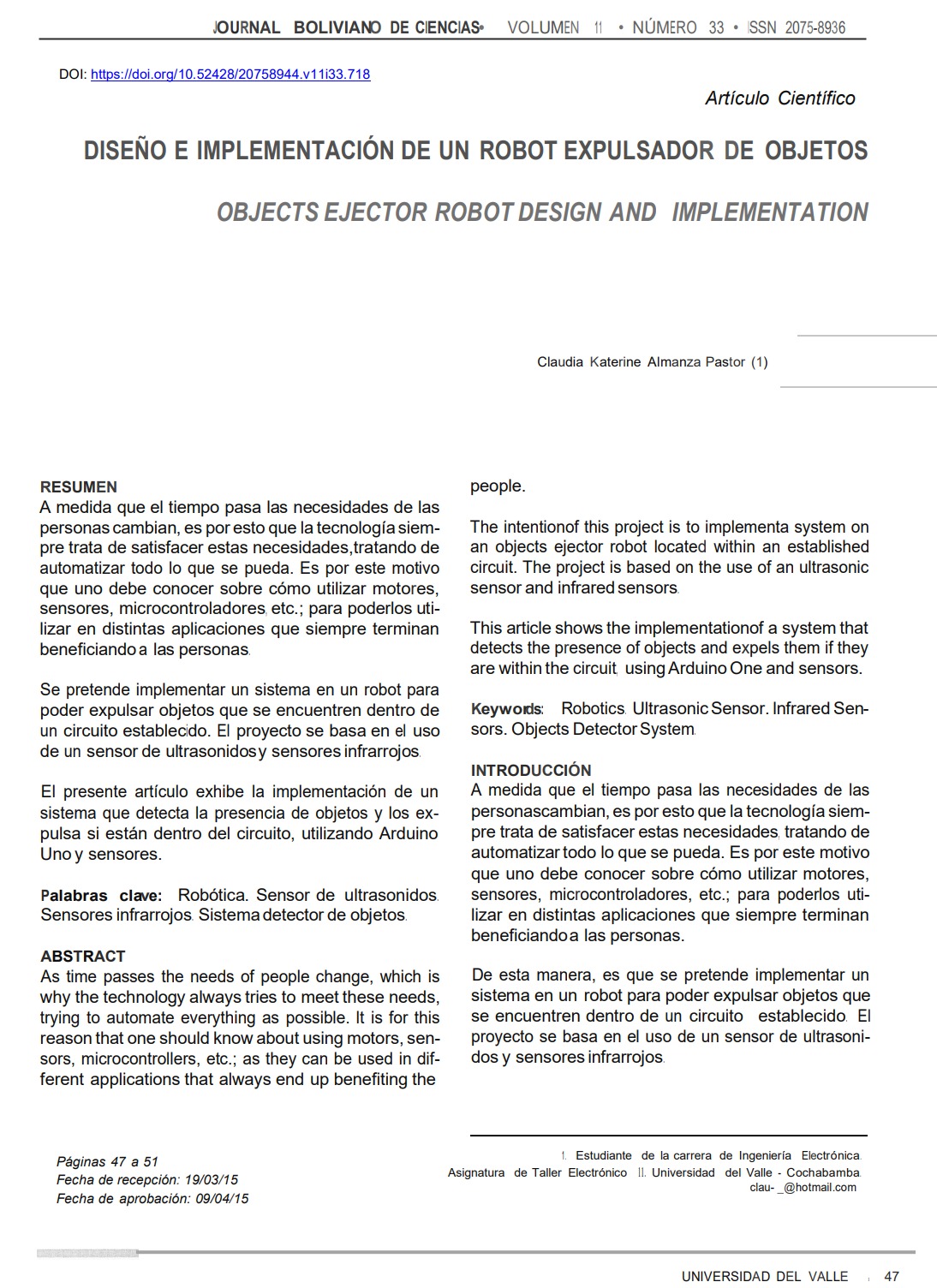Objects Ejector Robot Design and Implementation
DOI:
https://doi.org/10.52428/20758944.v11i33.718Keywords:
Robotics, Ultrasonic Sensor, lnfrared Sensor, Objects Detector SystemAbstract
As time passes the needs of people change, which is why the technology always tries to meet these needs, trying to automate everything as possible. lt is for this reason that one should know about using motors, sensors, microcontrollers, etc.; as they can be used in different applications that always end up benefiting the people.
The intention of this project is to implement a system on an objects ejector robot located within an established circuit. The project is based on the use of an ultrasonic sensor and infrared sensors. This article shows the implementation of a system that detects the presence of objects and expels them if they are within the circuit, using Arduino One and sensors.
Downloads
References
(1) Sensor ultrasónico http://es.wikipedia.org/wiki/Sensor_ultras%C3%B3nico (28 de febrero 2014).
(2) PÉREZ, Diego. Sensores de distancia por ultrasonidos http://picmania.garcia-cuervo.net/recursos/redpictutorials/sensores/sensores_de_distancias_con_ultrasonidos.pdf (s.f.) (19 de noviembre 2013).
(3) Sensor Infrarrojo http://es.wikipedia.org/wiki/Sensor _infrarrojo (7 de mayo 2014).
(4) Sensor infrarrojo http ://tdrobotica.co/noticias/50-sensor-infrarrojo (s.f.) (7 de mayo 2014).
(5) Otros motores http://tienda.tdrobotica.co/categoria/55 (s.f) (28 de febrero 2014).
(6) SALCEDO, Pedro. PLATAFORMAARDUINO http://www.educagratis.org/moodle/course/view.php?id=473 (s.f.)
(7) THINKBIT. Sensor Ultrasonidos HC SR04 http://www.thinkbit.org/practica7/sensor_objdec_ultra_hc_sr04_7-2/(19 de noviembre 2013).
(8) GARCÍA, Jesús, ZAVALETA, Abraham. Sensor Óptico de presencia http://pacific.fip.unam.mx/cursos/sensor%20optico/index.html (2010) (28 de febrero 2014).
(9) NYPLATFORM. TCRT5000 IR reflex sensors Obstacle avoidance modules tracing sensor module http://www. nyp I atform. co m/i nd ex. p h p? ro ute=p roduct/product&product_id=747 (s.f.)(7 de mayo 2014)

Downloads
Published
How to Cite
Issue
Section
License
Copyright (c) 2015 Claudia Katerine Almanza Pastor

This work is licensed under a Creative Commons Attribution 4.0 International License.
Authors who publish with this journal agree to the following terms:
- Authors retain copyright and grant the journal right of first publication with the work simultaneously licensed under a Creative Commons Attribution License 4.0 that allows others to share the work with an acknowledgement of the work's authorship and initial publication in this journal.
- Authors are able to enter into separate, additional contractual arrangements for the non-exclusive distribution of the journal's published version of the work (e.g., post it to an institutional repository or publish it in a book), with an acknowledgement of its initial publication in this journal.
- Authors are permitted and encouraged to post their work online (e.g., in institutional repositories or on their website) prior to and during the submission process, as it can lead to productive exchanges, as well as earlier and greater citation of published work.














